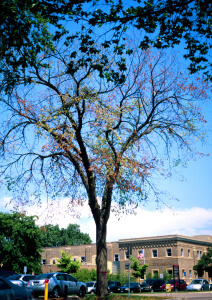
Prune Now: As the weather in our Nation’s capital is growing colder the opportunity to prune Elm trees is fast approaching. Unlike other species of trees that can be pruned year round the Elm tree typically needs to be pruned during the coldest parts of winter to protect the tree from the deadly Dutch Elm disease*. By pruning during the coldest parts of the season you provide your Elm tree with all the benefits of pruning without the risk of infection.
History of Dutch Elm Disease:
Dutch Elm disease, one of the most destructive shade tree diseases in North America, is caused by a fungus spread by the elm bark beetle. First reported in the U.S in 1928, the disease is believed to have been brought over from the Netherlands in a shipment of logs. Out of the 77 million elms in North America in 1930, over 75% had been lost by 1989. To this day, the Elm population across the United States is still battling this toxic disease.
Signs & Symptoms of Dutch Elm Disease:
- Leaf wilting
- Curling and yellowing/browning of leaves
- Premature leaf drop
- Branch death
- Death of the tree
Treatment & Preventative Care:
Sadly, there is no cure for Dutch Elm disease once your tree is infected. If infected there are some strategic treatments that can be administered to slow down the progression of the disease; however, prevention is truly the only action to stop Dutch Elm disease. If you have an elm that is not yet infected by Dutch Elm disease our Arborists recommend diligently following a tree health care plan.
A proper health plan for Elm trees would include:
- Soil management
- Bio-stimulant treatments
- Preventative fungicide treatments every 3 years
- Pruning every 2-5 years during the dormant season
- A monitoring program
If you are a Canopy Protection Program member with an Elm tree, rest assured you have a customized health plan to prevent the infection and spread of Dutch Elm disease.
*In specific situations based on the recommendation of the Arborist, Elms can be pruned during Spring, Summer, and Fall. In these cases extra precautions are taken to lessen the risk of infection. Precautions used by RTEC include sterilizing pruning instruments, only removing deadwood, and preventative injections.


